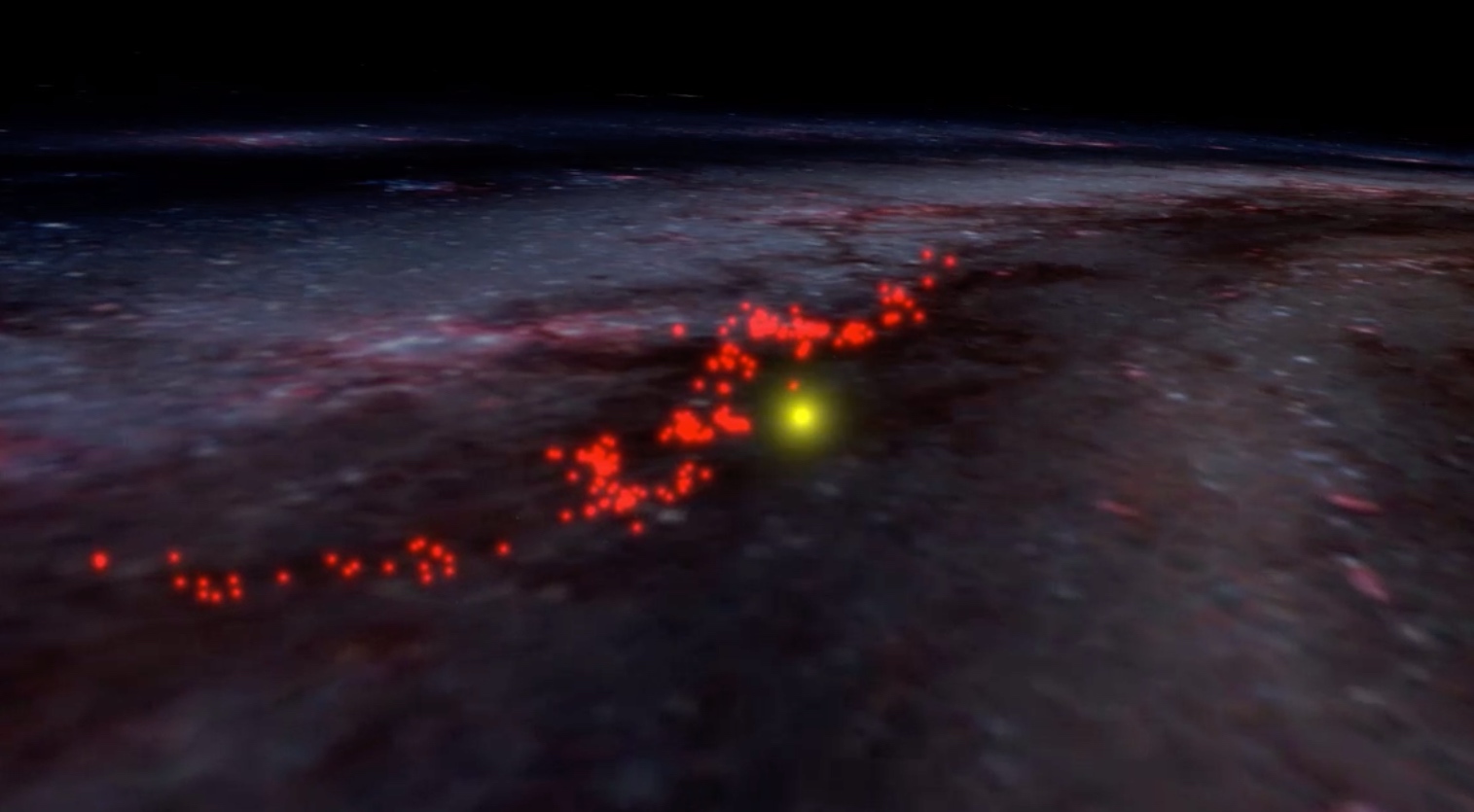IoW_20200108 - Gaia
Image of the Week |
the largest ever seen gaseous structure in our galaxy
|
|
In this illustration, the newly found wave-shaped gaseous structure called the "Radcliffe Wave" is overlaid on an image of the Milky Way galaxy. Image from the WorldWide Telescope, courtesy of Alyssa Goodman. |
|
Once again Gaia helps to advance our knowledge of the structures in our galaxy. A team of astronomers from the Vienna and Harvard Universities have discovered a wave-shaped gaseous structure. In honour of the collaboration's home base, the structure was named the Radcliffe Wave. This structure is the largest ever seen in our galaxy and is made up of interconnected stellar nurseries. The accurate data from Gaia played an essential role in this discovery: through mapping the interstellar matter in the Milky Way the team noticed this unexpected pattern in the spiral arm close to Earth. The structure appears to be undulating and can be well described by a damped sinusoidal wave on the plane of the Milky Way, with an average period of about 2 kpc and a maximum amplitude of about 160 pc. The found structure is long and thin, extending to about 9000 light-years but only 400 light-years wide with a height of about 500 light-years above and below the mid-plane of the Galaxy's disk. In the below video the location and shape of the structure can be seen in more detail. “We don’t know what causes this shape but it could be like a ripple in a pond as if something extraordinarily massive landed in our galaxy,” said Alves. “What we do know is that our Sun interacts with this structure. It passed by a festival of supernovae as it crossed Orion 13 million years ago, and in another 13 million years it will cross the structure again, sort of like we are ‘surfing the wave’.” “No astronomer expected that we live next to a giant, wave-like collection of gas–or that it forms the Local Arm of the Milky Way,” said Alyssa Goodman, Professor of Applied Astronomy and co-director of the Science Program at the Radcliffe Institute of Advanced Study. “We were completely shocked when we first realized how long and straight the Radcliffe Wave is, looking down on it from above in 3D – but how sinusoidal it is when viewed from Earth. The Wave’s existence is forcing us to rethink our understanding of the Milky Way’s 3D structure.”
Video illustration of the Radcliffe Wave. The illustration is overlaid on an image of the Milky Way galaxy (Image from the WorldWide Telescope). Courtesy of Alyssa Goodman / Harvard University.
Many of the clouds that were thought to be associated with the Gould Belt are now thought to be associated to this Radcliffe Wave, and the very finding of this structure is inconsistent with the previous theory that these clouds are part of a ring. “More than 150 years ago, Gould and Herschel both found a ring of bright stars projected on the sky, so for a long time people have been trying to figure out the origin of this ring,” said 2018-2019 Radcliffe fellow João Alves, a professor of Stellar Astrophysics at the University of Vienna and first author on the study. “Instead, what we’ve observed is the largest coherent gas structure we know of in the galaxy, organized not in a ring but in a massive, undulating, narrow and straight filament. The Sun lies only 500 light-years from the Wave at its closest point. It’s been right in front of our eyes all the time, but we couldn’t see it until now.” With new discoveries, new questions arise. With these findings disputing the Gould Belt model, they call for a revision of the architecture of gas in the Local Neighbourhood and a re-interpretation of phenomena generally associated with the Gould's Belt. One can expect many more interesting findings when astronomers dig deeper and deeper into the structure of our Milky Way. Gaia Data Release 2 lifted the application of innovative statistical methods to a new level in astronomy, both through its size and its accuracy. In the third quarter of 2020, the next Gaia data release is expected, Gaia Early Data Release 3, which will provide an even more accurate data set for the scientific community. “Studying stellar births is complicated by imperfect data. We risk getting the details wrong because if you’re confused about distance, you’re confused about size and mass,” said Finkbeiner. References:
|
|
Credits: Research team: J. Alves (University of Vienna), C. Zucker (Harvard University), A.A. Goodman (Harvard University), J. S. Speagle (Harvard University), S. Meingast (University of Vienna), T. Robitaille (Aperio Software), D.P. Finkbeiner (Harvard University), E.F. Schlafly (Lawrence Berkely National Laboratory), G.M. Green (Stanford University). Harvard Correspondent: Mary Todd Bergman. [Published: 08/01/2020] |
- Removed a total of (12) style text-align:center;
- Removed a total of (5) style text-align:justify;
- Removed a total of (1) border attribute.
- Removed a total of (1) cellpadding attribute.
- Removed a total of (1) cellspacing attribute.
- Converted a total of (1) youtube to youtube-nocookie.
Image of the Week Archive
- Removed a total of (1) border attribute.
- Removed a total of (1) cellpadding attribute.
- Removed a total of (1) cellspacing attribute.








































 Sign in
Sign in
 Science & Technology
Science & Technology
